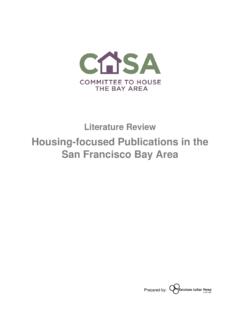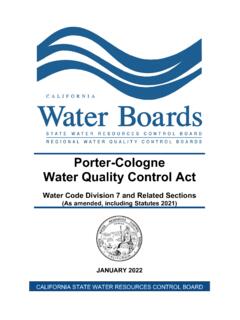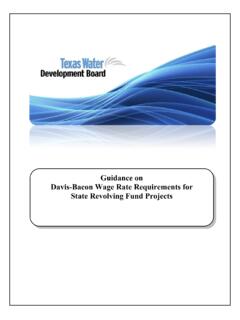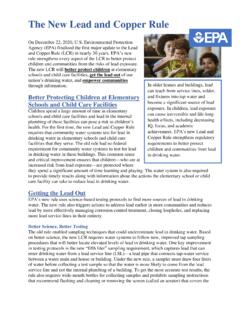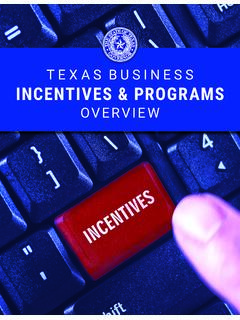Transcription of Bipartisan Infrastructure Law Summary November 12, 2021
1 Bipartisan Infrastructure Law Summary November 12, 2021. On November 5, Congress passed the Infrastructure Investment and Jobs Act ( 3684), known as the Bipartisan Infrastructure Law (BIL). BIL is a roughly $1 trillion transportation, water , broadband and electric grid Infrastructure bill that is intended to deliver on a portion of President Biden's jobs, climate and equity agenda. It is widely anticipated that the Infrastructure law will be supplemented by a Build Back Better spending package, expected to be slightly less than $2 trillion. A Summary of the Infrastructure bill follows. BIL would invest nearly $1 trillion in transportation, water , broadband, and power Infrastructure as well as resilience investments. Of this amount, approximately $550 billion would be new spending (the nearly $1 trillion dollar amount in the chart reflects the cost to also maintain existing spending levels for certain Infrastructure , including surface transportation and water ). Total spending amounts by Infrastructure category are detailed in the chart below.
2 Bipartisan Infrastructure Law Act Spending Categories ($ in Billions). Funding1. Infrastructure Category Amount Surface Transportation $639. FAST Act Reauthorization $477. IIJ Act Stimulus (supplemental spending) $157. Electric & Low Emission School Buses $5. Airports $25. Ports and Waterways $17. water Infrastructure $91. Broadband $65. Power Infrastructure $65. Resilience, Western water Storage and $71. Environmental Remediation Transportation Total $681. Other Infrastructure Total $292. Total $973. Source: MTC analysis of 3684, Eno Transportation Weekly and White House Fact Sheet Transportation - $681 billion Transportation Infrastructure is by far the largest component of the Infrastructure bill. Regarding surface transportation, the bill combines a roughly $477 billion five-year surface transportation reauthorization a 56 percent increase above Congress's last five-year transportation bill, the Fixing America's Surface Transportation (FAST) Act with approximately $157 billion in 1.
3 BIL includes $550 billion in new spending ( , above baseline spending ). Amounts for FAST Act reauthorization amounts reflect baseline plus new spending. water Infrastructure amounts reflect baseline spending for the longstanding Environmental Protection Agency water revolving loan funds plus new spending. The remaining spending categories are reflective of "new" spending (above baseline) only. 1. supplemental one-time stimulus funding to be distributed to more than two dozen grant programs over five We estimate that the bill would provide about $ billion in guaranteed . funding for the Bay Area via the highway and transit formula funds that MTC distributes. We also expect Bay Area projects to receive a share of the state's $ billion in bridge repair funds and dedicated resources for zero emission vehicle charging and resilience projects. Attachment A. provides a more detailed overview of the surface transportation provisions of the bill. The most unprecedented element of the deal is in the scale of new discretionary grants that would be administered by the Department of Transportation (USDOT); the bill would authorize approximately $140 billion in competitive grant funding that could help fund Bay Area surface transportation priorities).
4 See page 3 of Attachment A for additional details on the discretionary grants. The bill would also provide funding for airports, ports and waterways, as shown in the chart on Page 1. water Infrastructure water Infrastructure would be funded at approximately $91 billion and similar to surface transportation includes a reauthorization of drinking and wastewater funding ($36 billion) and provides supplemental one-time stimulus funding to targeted programs. Nearly $53 billion would be distributed through the existing drinking water and clean water state revolving loan funds ($ billion each) which provide grants to states for loans supporting water Infrastructure and water quality improvement projects. An additional $15 billion would be available for lead pipe replacement (to be administered through drinking water state revolving loan funds) and $10. billion to address emerging pollutants. The remaining funding would be distributed through various other programs. Broadband/High-Speed Internet The Infrastructure bill provides $65 billion to help build out broadband Infrastructure , assist states with developing and implementing digital equity plans, and to subsidize the cost of Internet service for low-income households.
5 Of the funding, $ billion would be reserved for a Department of Commerce broadband buildout grant program for states . Each state would receive a minimum of $100 million; remaining grant funding would be determined via a formula based on each state's proportionate number of underserved and high-cost locations. Another significant component of the broadband proposal is a $30/month voucher that low-income families may use for Internet service ($ billion cost). This subsidy builds on the existing Emergency Broadband Benefit established during the pandemic, removing any sunset date for the benefit and expanding eligibility to more low-income households. An estimated million Californians would be eligible for the benefit, according to a White House fact sheet. 2. Of the $477 billion in FAST Act reauthorization funds, only $383 billion in funding is tied to contract authority, which is a mandatory form of budget authority. This provides a degree of certainty that authorized funding will be available each fiscal year.
6 There is much less certainty that the remaining $94 billion will ultimately be funded by Congress. Intercity and freight rail comprises 38 percent of this "uncertain" funding, multimodal grant programs account for 24 percent, Capital Investment Grants (which fund transit expansion and modernization) and Federal Highway Administration discretionary grants each account for roughly 16 percent and the remaining funds are directed to research, motor carrier safety and other areas. The full $477 billion is reflected in this Summary to demonstrate the full scope of authorized funding in BIL. 2. Power Infrastructure and Clean Energy BIL includes $65 billion to upgrade power Infrastructure and increase energy efficiency, creates a new Grid Deployment Authority, and invests in clean energy research and technology. Investments of interest include: $5 billion in grants to states , grid operators, and other entities to harden the electric grid against extreme weather events, $5 billion for demonstration projects aimed at hardening and enhancing grid resilience, $3 billion for the Smart Grid Investment Matching Grant Program with expanded eligibilities to include improvements that increase flexibility in responding to natural disasters and fluctuating demand , $8 billion to establish at least four regional clean hydrogen hubs, $550 million for the Energy Efficiency and Conservation Block Grant Program to support state and local governments in investing in energy efficiency and conservation projects and $225 million for a Department of Energy competitive grant program for states or regional partnerships to update their building energy codes.
7 Resilience, Western water Storage, Environmental Remediation The bill would provide about $71 billion for resilience, western water storage and remediation, including funding for wildfire resilience, flood mitigation, and ecosystem restoration. Regarding wildfires, the bill includes $ billion for wildfire risk reduction efforts, including controlled burns, community wildfire defense grants, and funds to boost federal firefighter salaries. The bill would additionally provide $2 billion for federal ecological restoration projects to support fuel reduction. Other investments of interest: $ billion to supplement the Weatherization Assistance Program that reduces energy costs for low-income households3. $1 billion is provided for the Federal Emergency Management Administration (FEMA)'s Building Resilient Infrastructure and Communities (BRIC) grants $1 billion for a new grant program for states and local governments to develop and implement cybersecurity plans $24 million for San Francisco Bay restoration (funds will go to EPA) and $132 million for the National Estuary Program, of which an estimated $ million would come directly to the San Francisco Estuary Partnership over five years ($900,000/year).
8 This would more than double the Partnership's current annual federal funding of approximately $700,000. $17 billion for Army Corps of Engineers flood mitigation and waterways management planning and projects, including $ billion for construction (intended to support both unfunded projects in the Army Corps pipeline and new construction).4. More than $8 billion for water storage, recycling, and ecosystem restoration intended to help make California and other western states more resilient to drought $ billion over five years for brownfield remediation $ billion for superfund remediation 3. Weatherization funding could also be categorized under power Infrastructure and clean energy funding. 4. Based on external Infrastructure bill analyses, staff attributed Army Corps funding to the resilience category, though a portion of the $17 billion most likely accounts for a significant amount of the ports and waterways . funding listed in the chart on Page 1. 3. Attachment A. Summary of Surface Transportation Provisions of the Bipartisan Infrastructure Law November 12, 2021.
9 This writeup provides highlights of the surface transportation aspects of the Infrastructure Investment and Jobs Act known as the Bipartisan Infrastructure Law (BIL) with a focus on Bay Area impacts. As shown in the chart below, the bill combines a $477 billion five-year surface transportation reauthorization a 56 percent increase above Congress's last five-year transportation bill, the Fixing America's Surface Transportation (FAST) Act with approximately $157 billion in supplemental one-time stimulus funding to be distributed to more than two dozen grant programs over five years. 1. Investment and Jobs Act vs. FAST Act Comparison Chart FAST Act BIL. %. (FY 2016-2020) (FY 2022-2026). Increase blank Surface Transportation Authorization $ 305 billion $ 477 billion 56%. One-time General Fund advance appropriation) - $ 157 billion N/A. Total Authorized Funding $ 305 billion $ 634 billion 108%. Chart does not yet reflect the fiscal year (FY) 2018 through FY 2020 Highway Improvement Program and Transit Infrastructure Grants, which supplemented highway and transit funding.
10 Bay Area Highway and Transit Formula Funding Increase BIL would substantially boost the Bay Area transit formula resources that MTC distributes, and the Bay Area would receive a lesser but not insignificant boost in flexible highway funds. Initial estimates are below and are subject to change. Bay Area Transit The Infrastructure bill would provide the Bay Area $ billion in transit formula funds over five years vs. the $ billion in Federal Transit Administration (FTA) formula funds over the FAST. Act period, as shown below. Bay Area Transit Formula Fund Estimate Blank FAST Act BIL 5-Year Funding (FY 2016-2020)1 (FY 2022-2026)2 Increase State of Good Repair $ billion $ billion $ billion Urbanized Area $ billion $ billion $ billion Other $ billion $ billion $ billion Total $ billion $ billion $ billion Sums may not total due to rounding. FAST Act and BIL amounts include funding from supplemental appropriations. 1. Transportation authorization bill funding reflects both Highway Trust Fund (HTF) amounts which are essentially guaranteed in addition to those funding amounts authorized but subject to the uncertainty of the annual appropriations process.

